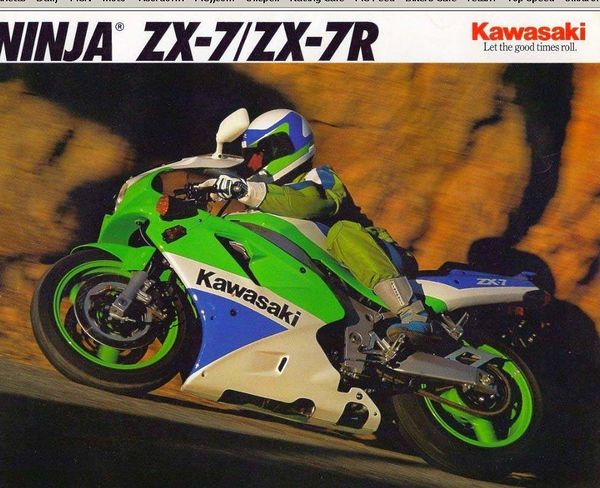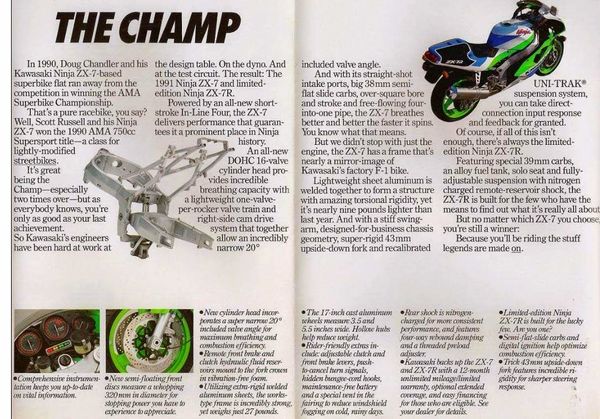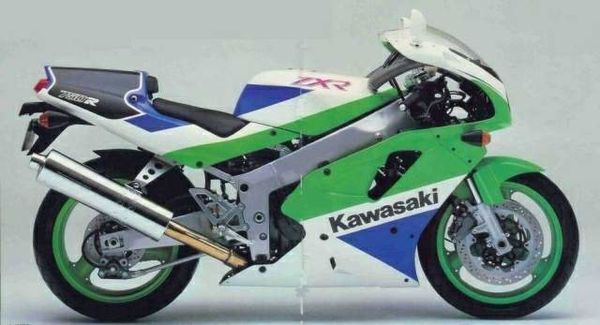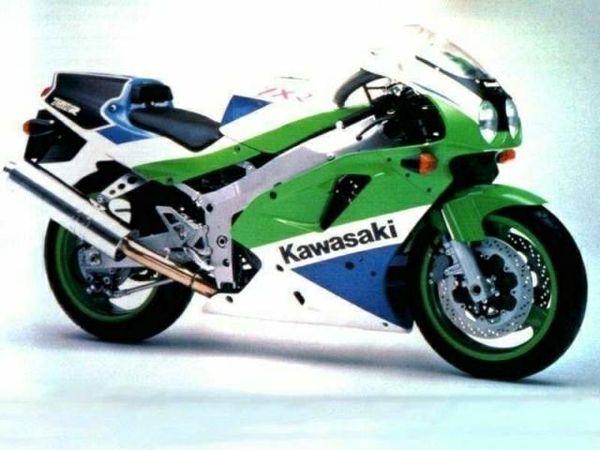Kawasaki ZX-R 750R K
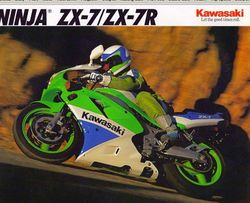 |
|
| Kawasaki ZX-R 750R K | |
| Manufacturer | |
|---|---|
| Production | 1991 |
| Class | Sportbike |
| Engine | Four stroke, transverse four cylinder, DOHC, 4 valves per cylinder. |
| Compression ratio | 10.8:1 |
| Top Speed | 256.5 km/h / 159.3 mph |
| Ignition | Digital |
| Spark Plug | NGK, CR9E |
| Transmission | 6 Speed |
| Frame | Aluminum perimeter |
| Suspension | Front: 41mm Upside-down forks, adjustable ride height, 13-way rebound, 8-way compression. Rear: Uni Track monoshock. adjustable ride height, preload, 4-way rebound. |
| Brakes | Front: 2x 320mm discs 4 piston calipers Rear: Single 230mm disc 2 piston caliper |
| Front Tire | 120/70 ZR17 |
| Rear Tire | 180/55 ZR17 |
| Wheelbase | 1420 mm / 55.9 in |
| Weight | 190 kg / 418.8 lbs (dry), |
| Recommended Oil | K-tech 10W-40 |
| Fuel Capacity | 18 Liters / 4.7 US gal |
| Manuals | Service Manual |
It could reach a top speed of 256.5 km/h / 159.3 mph.
Engine[edit | edit source]
The engine was a Liquid cooled cooled Four stroke, transverse four cylinder, DOHC, 4 valves per cylinder.. The engine featured a 10.8:1 compression ratio.
Drive[edit | edit source]
Power was moderated via the Multi plate wet (oil submerged) hydraulic slipper clutch.
Chassis[edit | edit source]
It came with a 120/70 ZR17 front tire and a 180/55 ZR17 rear tire. Stopping was achieved via 2x 320mm discs 4 piston calipers in the front and a Single 230mm disc 2 piston caliper in the rear. The front suspension was a 41mm Upside-down forks, adjustable ride height, 13-way rebound, 8-way compression. while the rear was equipped with a Uni Track monoshock. adjustable ride height, preload, 4-way rebound.. The ZX-R 750R K was fitted with a 18 Liters / 4.7 US gal fuel tank. The bike weighed just 190 kg / 418.8 lbs. The wheelbase was 1420 mm / 55.9 in long.
Photos[edit | edit source]
Overview[edit | edit source]
Kawasaki ZX-R 750R-K
If bikes where footballers the ZXR750J would be Paul
Gascoigne. Both arc touched by genius, which they waste. To the
punters in their terraces and their Kawasaki cockpits, that's a
crime.
Frustration eats me up each ride. I want to kick it but usually it gets a
reluctant pat. The Kawasaki ZXR750J confounds me. It's like that twot Gascoigne.
Here's why.
Potentially it has no limits. On smooth roads its chassis is a
frame-builder's textbook. But since smooth roads don't exist, theoretical
perfection is destroyed by kidney scrambling rear suspension. If Sumo wrestlers
don't ride bikes, they should. Kawasaki has just the machine.
Too much power is rarely enough for anyone, ZXR-types especially. They don't
just want paddock jackets they want b-h-p and enough of it would probably
diminish the debilitating effect of that suspension. Yet after the peaky 1990
106bhp H2, thej's horses were pushed down the rev range then capped by KMUK's
voluntarily adopted 100bhp limit. The result is a crisp, exactingly carburated
engine which, between four and 9000rpm, has few peers with few memorable moments
either. This in a ZXR is wrong. By definition it should be mean, and if not
peaky then well worth revving. The J isn't; its top-end delivery has been tamed,
which has narked more than one H owner who's chopped his raucous speedball for a
J.
So the obsolete 114bhp oil-cooled Suzuki GSX-R glides serenely off into the
middle distance. The potentially better bike loses. Tearful Gazza, limping and
crying because he kicked someone, sits on the bench while a dour journeyman
pulls on his England shirt. Which hurts.
Enter Linus Ridge and his ZXR750K1, a J-Plus if you like, more evocatively
referred to as the R. Linus doesn't have problems with GSX-Rs. He has a claimed
extra 21 bhp to blat them with; five kg fewer to haul around and all sorts of
twiddlcy knobs on his rear suspension to experiment with. Can I have a go please
Linus?
For two bikes that look so similar are so similar the R has a
dramatically different angle of attack. Metaphorically it stays home to scoff
live chicks while the J's out getting busted-up in nightclubs. Literally it
rides higher, feels narrower and less slabby. The idiot lights vibrate, the bars
tingle and the throttle's heavier too. It's a race bike.
On public roads the R's chassis is at most five per cent keener all round:
braking deeper, turning quicker, gripping harder. But when its tacho clears
8000rpm the R's untethrered engine pulverises 1991 standards of 750cc
performance.
Taps are wide open at 9000. The shock is loaded, the die-young rear Hi-Sport
clings fast with a proverbial death-grip. Down a slip road the chassis nods
under 2nd-3rd-4th gear close-ratio acceleration, merging with motorway traffic
like a Tornado gatecrashing a Tiger Moth convention. Where thej is asthmatic at
11,000rpm, the R puffs out its chest and moves into the litre-plus super league.
Snicked shifts, sooo much smoother than our needs-a-service J, hardly drop the
bouncing tacho needle by 1000rpm. Stability is absolute, I was absolute, I
thought it would accelerate forever, that I could be home before I'd left that
morning. I felt five per cent keener too.
At Bruntingthorpe it clocked 150mph into a headwind and the J managed 140mph.
Linus's bike is the real ZXR, the one that goes like it looks. Which also hurts
I expect.
Although some J riders may feel aggrieved that only the monied can experience
the ZXR's full potential, in context with other staggeringly enormous bike
prices the R isn't a rich yob's toy at all. That is, if a modern Jap 750 is
'almost feasible money' and OW01s and RC30s are 'creatures from a far flung
fiscal galaxy' then Kawasaki's race-exotic 750 is, at £7699, only 'just out of
reach'. It's £1570 more than the J, £700 up on a Yamaha FZR1000 but £3800 less
than an RC30 (or about 30 grand cheaper than an NR750).
The beauty of the ZXR brothers is their compatibility. The J acts as a
mass-produced canvas on which an R (120 imported this year) can be painted
without fetching silly money. The R, in turn, is an off-the-peg racer (although
only a handful have actually been raced) in which to install an OW01-worrying
factory race kit. For those who want need the mostest, knowing that
selected R-bits can be accomodated in Js must be as sexy as it is harrowing.
They think: I can almost afford those cams etc. What else can I sell?
If it's horsepower they're after, I'd say R performance is worth the
furniture. It's immaculately dedicated. Otherwise, beyond pose value, I'm not so
sure.
Achieving R-style handling would be fairly straight forward but an expensive
route a marginally sharper roadbike. The thicker walled, longer travel fork
stanchions are strangely two mil' thinner in diameter (no-one seems 100 per cent
clear as to why: possibly to save weight, maybe to reduce stiction) and have
seven-way adjustable compression damping which Linus runs mid-set. The R's rear
shock has the spring and damping rates of the J's so it's (groan) rock hard.
There is, however, a discernable improvement which, although hard to pinpoint,
is probably due a combination of factors.
The shock does at least have 20-way compression damping adjustment on the
remote gas cylinder which Linus runs on minimum plus one click. So twiddled, it
does little other than expose the brutal spring (KMUK has now introduced an
optional spring which lowers the standard rate from 7.5kg/mm to 6.5kg/mm), but
anything that can be turned to soft acts as a massive psychological cushion. The
other variables are those very sticky Michelins (which definitely reduced
harshness on the old ZXR/H1), a 15mm longer shock-stroke and, on Linus's R, a
10mm higher ride height (adjusted at the shock's top mounting point).
With the spring preload wound down the overall effect gives a marginal
improvement in comfort the bum-high/ crook-neck riding position taking on an
ergonomic rather than masochistic meaning over a wider variety of speed ranges
and road surfaces alike. And handling is, well, five per cent.
It's barely noticeable the Hi-Sports alone must account for four per cent
yet everything is more. Stability is more, yet it drops into turns quicker;
steering is more precise and more accurate, and so on. Ultimately, though, I
think Linus's bike was simply set-up better than our long term J and only a
track test could judge for sure.
The amazing front brakes/inverted forks double act, for example, was no
better (could it be?) or worse with the R's thinner but massively rigid 41mm
stanchions. Both are tremendously progressive and unflappable. Again, only the
Michelins split the J and R significantly, tempting late brakers to hold the
lever deeper into a turn. And that's where plenty of J riders already invest
their money (and that's every thousand miles or so!).
The R did, however, feel much more than just five kg lighter; close, in fact,
to an FZR600. But that's what the press pack says: five kilos, same wheelbase,
same rake and trail, same everything. Yet it's the best. Find me a grid, I know
how John Reynolds does it now.
Life with an R isn't all a power-fiend's Utopia though. If it were, Kawasaki
would probably have given us Js that were closer to Rs. Linus has neither
aerofoil nor bungee hooks. Less flippantly, he pays for his toy in both hard
cash (he's managed to get onto reserve after 58 miles convinced the ally tank is
smaller than standard) and in sometimes rather borderline road manners.
That's the price of all those ponies. The two engines are essentially similar
but the R's has been adapted to flow better at high revs at the blatant expense
of the J s mid-range. Its top-end reverts to cams with the same high lift and
long 280° duration as the H2. Compression is raised from 10.8:1 to 11.5:1 by
replacing the J's concave-top pistons with flat-tops and the rev-limiter cuts in
800rpm later at 12,800. Finally, and most crucially, 38mm CV carbs have been
substituted by a bank of 39mm Keihin smooth-bore flat slides. And they sound
quick to me.
These are the feathers in the R's cap. Racers will love them because once an
engine's wearing a race-pipe and a monster-raving tune, they yield massive
advantages over notoriously fickle CVs. Super-bike rules permit only standard
carbs, and the R was always intended for Superbikes...
On the road it's less simple. With an air-box and road-legal pipe restricting
the R's breathing and the lower and middle ranges staking a claim to decent
carburation, Kawasaki added an accelerator pump and a fuel enrichening circuit
that shoots neat unleaded down the inlet tracts between tickover and about
5000rpm. Linus says it's an impressive sight, but trusty CVs they are not,
which, in tandem with a massively tall first gear, makes the R feel at times
like a half-finished special.
The worst scenario sees it trailing the J (over a bumpy road) at pootling
speed. The J accelerates cleanly into its useful mid-range, the R fluffs, won't
pick up and stops dead like a refusal at Beechers Brook. The rider nuts the
fairing.
Throttle openings below 7000rpm have to be surreptitiously selected. Merely
winding it open won't do because a travelling flat spot follows the tacho needle
to wherever it's hiding. Although the R's overall gearing is lower, that 80mph
first gear followed by five tightly spaced ratios blocks any escape route.
Careful feathering and clutch play are required until the tubes begin to clear
at 7000.
Then the flat slides work, response returns and the world goes backWards -
jolly fast. In fact, so long as you don't try to rule the throttle with a
rod of iron, the R will always pull through its midrange. At Bruntingthorpe it
surprised everyone by losing no more than a a few yards to the J in roll-on
tests. All said, 4500rpm and a slipping clutch can be a bit depressing after a
long day entertaining Linus.
What the hell. It's still my bike of the year, even if seven grand doesn't
buy you a real-roads shock, something Suzuki offers for under six. Riding the J
home in fog and stop-go traffic I thought: if you're to own a ZXR what's the
point in having something restricted, that goes against the whole ZXR ethos? But
I was in top gear, lazily rolling the tacho needle around its mid-range, nipping
past a lorry here, a gaggle of Sierras there...I was riding a J and together,
knee deep in the detritus of real world traffic, we were doing very nicely thank
you.
But what a shame Kawasaki didn't invent the ZXR750JR.
Source Bike Magazine 1991
| Make Model | Kawasaki ZX-R 750R-K |
|---|---|
| Year | 1991 |
| Engine Type | Four stroke, transverse four cylinder, DOHC, 4 valves per cylinder. |
| Displacement | 749 cc / 45.7 cu-in |
| Bore X Stroke | 71 x 47.3 mm |
| Cooling System | Liquid cooled |
| Compression | 10.8:1 |
| Lubrication | Wet sump |
| Engine Oil | 10W/40 |
| Induction | 4x 39 mm Keihin CVKD (Constant Velocity) carburettors / Ram Air System (single intake) |
| Ignition | Digital |
| Spark Plug | NGK, CR9E |
| Starting | Electric |
| Max Power | 121 hp / 88.3 kW @ 10500 rpm |
| Max Power Rear Tire | 112.3 hp / 83.7 kW @ 11400 rpm |
| Max Torque | 7.4 kgf-m / 53.8 lb-ft @ 9750 rpm |
| Clutch | Multi plate wet (oil submerged) hydraulic slipper clutch |
| Transmission | 6 Speed |
| Final Drive | Chain |
| Frame | Aluminum perimeter |
| Front Suspension | 41mm Upside-down forks, adjustable ride height, 13-way rebound, 8-way compression. |
| Rear Suspension | Uni Track monoshock. adjustable ride height, preload, 4-way rebound. |
| Front Brakes | 2x 320mm discs 4 piston calipers |
| Rear Brakes | Single 230mm disc 2 piston caliper |
| Front Tire | 120/70 ZR17 |
| Rear Tire | 180/55 ZR17 |
| Rake | 24.5° |
| Trail | 95mm / 3.74 in |
| Wheelbase | 1420 mm / 55.9 in |
| Dry Weight | 190 kg / 418.8 lbs |
| Fuel Capacity | 18 Liters / 4.7 US gal |
| Consumption Average | 14.1 km/lit |
| Braking 60 - 0 / 100 - 0 | 12.5 m / 35.7 m |
| Standing ¼ Mile | 10.8 sec / 205.8 km/h |
| Top Speed | 256.5 km/h / 159.3 mph |
